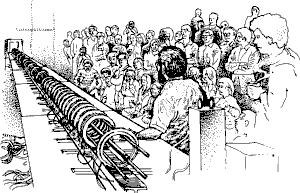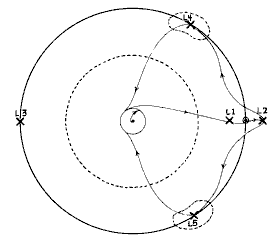To Senior Associates and Members
The 14th Space Studies Institute Conference on Space Manufacturing and Space Settlement will be held at NASA Ames Conference Center on October 30 and 31, 2010. Thirty five years ago, the Ames Research Center was the site of the first large technical study of space settlement. We have made significant progress since then, but with the prospect of low cost space transportation in the near future, now is the time to reinvigorate research and collaboration on the critical path technologies needed for space industrialization and settlement. This conference continues in the spirit of the SSI Princeton Conferences.
 The Space Manufacturing and Space Settlement Conferences have given SSI great value for its investment. This conference is the only one solely concerned with the science and engineering of humanity’s expansion into the solar system. Its most important function is to bring together the engineers, entrepreneurs and researchers who do the real work. New space companies and new institutions have formed from collaborations forged at earlier conferences. We hope that this and future annual SSI conferences will be as fruitful.
The Space Manufacturing and Space Settlement Conferences have given SSI great value for its investment. This conference is the only one solely concerned with the science and engineering of humanity’s expansion into the solar system. Its most important function is to bring together the engineers, entrepreneurs and researchers who do the real work. New space companies and new institutions have formed from collaborations forged at earlier conferences. We hope that this and future annual SSI conferences will be as fruitful.
The conference sessions and chairs are listed below.
Professor John S. Lewis, Conference Chair
Space Transportation Architecture: Gary C Hudson
Closed Environment Life Support Systems: Taber MacCallum
Robotics and Space Manufacturing: Professor Red Whittaker
Engineering Materials from Non Terrestrial Resources: Dr. Peter Schubert
Extraterrestrial Prospecting: Professor Michael A’Hearn
Space Solar Power and Space Energy Systems: Dr. Philip Chapman
International, Legal and Economic Considerations: James Dunstan, Esq.
Poster Session: Jim Burke
[Conference registration, call for papers and hotel information.]
Rational Satellite Solar Power Development May Depend on Funding for Deep Space Propulsion
 Satellite solar power still appears to be the best candidate to generate large economic returns from space development. The annual world market for new electrical generating capacity is roughly $500 billion per year. To compete for this multi-hundred billion dollar market, power satellite costs will have to be comparable to those from coal-fired and nuclear-powered generating stations. The principal barrier to further engineering development of the satellite solar power concept has been the high cost of Earth-to-orbit transportation. SSI believes that the cost of transportation to low Earth orbit will be low enough within a decade to make power satellites economical for spot power to remote locations.
Satellite solar power still appears to be the best candidate to generate large economic returns from space development. The annual world market for new electrical generating capacity is roughly $500 billion per year. To compete for this multi-hundred billion dollar market, power satellite costs will have to be comparable to those from coal-fired and nuclear-powered generating stations. The principal barrier to further engineering development of the satellite solar power concept has been the high cost of Earth-to-orbit transportation. SSI believes that the cost of transportation to low Earth orbit will be low enough within a decade to make power satellites economical for spot power to remote locations.

There is another technical barrier: We do not yet know how to design and construct power satellites. The largest power array now in orbit is the ISS power system rated at about 100 kW. An economical power satellite size to supply remote users and disaster areas is about 100 MW electric, a thousand times larger. There is much engineering development to be done to get from today’s laboratory demonstrations to the first 100 MW satellite. There is another big step to a commercial satellite able to supply baseload power competitively with existing infrastructure. To build power satellites economically, Peter Glaser, the inventor of the concept proposed a “terraced approach,” building capability in a stepwise fashion.
Fortunately, there is a niche market for power at remote locations like forward military bases and disaster areas. Power costs for these users are dollars per kilowatt hour. It is easier to make a business case for a power price of dollars per kilowatt hour than it is for the typical $.10 per kilowatt hour in the industrialized world. The US military is likely to be an anchor customer. A spot power system that could be flown in and set up in a few days would yield a roughly 15 percent reduction in the cost of maintaining a forward base. Such a system would also be invaluable to supply power in disaster areas.
These high energy cost applications need a power receiving system that is transportable in a standard cargo airplane. The requirement for a small spot beam size and ability to transport by air means that the power transmission technology will be by laser. Radio frequency transmission needs a kilometer scale receiver. The U.S. government’s power satellite evaluation studies done 30 years ago examined only radio frequency transmission, since laser transmission then was technically less mature, and since radio frequency transmission had already demonstrated the transmission efficiencies. Since that time, laser transmission efficiencies have increased dramatically and costs have fallen.
Radio frequency transmission is still important. It has everything needed for baseload power. It is unobtrusive, hazard free, and transmission efficiency is high. Nonetheless, it is difficult to see how to get through the evolutionary engineering steps to build a radio frequency baseload power satellite without first developing an economical spot power system.
It would be desirable to have the government pay for critical power satellite technology development since it is unlikely that the power generating industry will pay for such development. Power satellite design and beamed power transmission, however, overlap with the needs of manned deep space exploration. That overlap may provide a mechanism for a private company to develop the necessary hardware and construction techniques for building power satellites under the guise of providing deep space transportation solutions to NASA.
In the absence of nuclear rockets, there are only two ways to do propulsion that will meaningfully shorten trip times or reduce the mass required in low Earth orbit to do a manned deep space mission. Such a mission requires a multi-hundred megawatt system. One option is to beam power to a lightweight receiver on the spacecraft. The other is to find a way to make solar arrays very light. For rapid transit to Mars or the asteroids, very large solar arrays like those required for power satellites are necessary. Ideally, these large arrays would power the spacecraft using beamed energy. That way, the spacecraft would not have to accelerate the massive solar arrays; they would remain behind in high Earth orbit.
During his service on the Augustine commission, SSI Senior Adviser Jeff Greason recommended the development of very large solar arrays and beamed power as the preferred option for manned deep space exploration. The President alluded to this advanced technology in his speech at Kennedy Space Center on April 15.
Observations on the Flexible Path, NASA’s new national space policy
The new policy, which follows the recommendations of the Augustine commission, is very positive for SSI’s mission. The commission explicitly endorsed the expansion of human civilization into the solar system as the ultimate goal of our national space effort.
For a number of years, thoughtful observers noted that Constellation, the previous NASA architecture for return to the Moon, was unaffordable and therefore unsustainable. Even given technical success, the nation could not afford the cost of the effort, limited to two flights per year to the Moon.
Ares’ massive funding requirement crowded out all NASA spending on advanced technology development. So, for the past several years, NASA has done no advanced technology development. Some of the canceled technology initiatives were critical to lowering the cost of Earth to orbit transportation. The new plan restores funding for pre-competitive technology development that the entrepreneurial space access industry needs to build a cost-effective space transportation system for access to space. This is a positive development since low-cost Earth to orbit transportation is the first step on the critical path to space settlement.
In addition to the already existing Commercial Orbital Transportation Services agreements, the Administration’s plan mandates purchasing crew transportation services competitively. SSI expects that requirement to provide a market for entrepreneurial New Space companies to deliver low-cost access to space for people and cargo. As always, the devil is in the details, but we are hopeful that this new transportation market will enable multiple transportation providers to compete.
Not returning NASA astronauts to the Moon does not disappoint SSI. NASA will continue to do those robotic lunar exploration missions needed to characterize the deposits of water ice and other volatiles in preparation for commercial use. By canceling the plan for manned Moon missions, the president has removed NASA as a competitor to commercial enterprises like Bigelow Aerospace, which already has its sights set on the Moon.


The flexible path advocated by the Augustine commission permits large cost savings because the elements of the transportation architecture can be developed sequentially rather than simultaneously. Commentators in the press have overlooked that cost-saving advantage.
In addition to the other positive features, the President has requested a tripling of funding for asteroid search and orbit characterization. SSI has been recommending that action for 15 years.
Critical Path Technology Development
We have had preliminary discussions about construction of a closed environment life-support test article, something we hope to be able to achieve in this decade. We are also constructing a Critical Path technology development roadmap to assist planning SSI research investments in the future. The focus of the upcoming conference will be to identify hardware research for SSI to sponsor and support.
Since the move last year from Princeton to Mojave Air and Space Port, many SSI Senior Associates, Members and Senior Advisers have stepped up to volunteer services and support. Special thanks are due to Douglas Graham and Robin Snelson for assistance with all aspects of SSI’s revival.
As always, SSI is constrained by the funding available. Thank you for your support in the past and if possible, please renew your subscription or make a donation to support the Institute’s continued work.
The settlement of space is our job. If we do not do it, no one will.
Best regards,
Lee Valentine
Executive Vice President
Space Studies Institute
1434 Flightline St.
Mojave, CA 93501
661-750-2774
Space Studies Institute is a non-profit 501(c)(3) organization. Contributions to SSI are tax-deductible to the extent permitted by law. We invite you to join, renew your membership or make a donation here.
Illustrations © Donald E. Davis, The High Frontier
Heading to D.C. with Pete Worden? Swing over to NASA Ames first with SSI
This week Dr. Peter Worden, United States Air Force Brigadier-General (retired), Director of...

